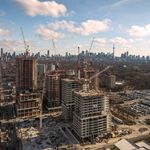SunriseChampion
Senior Member
It doesn't really matter how much it might cost if there don't exist the people to build it all.
It could cost a dollar and it wouldn't get done.
It could cost a dollar and it wouldn't get done.
It doesn't really matter how much it might cost if there don't exist the people to build it all.
How long does training take for plumbing/electrical/drywall/etc? 2 to 3 years? I'm sure it varies somewhat by trade.
Lack of people seems a surmountable problem over a 5 to 10 year period IFF the province directed re-education funding at it. Anyone able-bodied on the wait list who is currently unemployed could be retrained as a trade and put onto a government housing project. The quality of the first few buildings would likely be pretty poor but by the 10th they'd start getting up to standard.

There's lots of options of reducing costs and delivering units- but you'd need to look further than North America to find them.
For instance, Keesmaat could go the self-build/incremental housing route.

https://www.researchgate.net/figure...le-Elemental-Monterrey-Make-it_fig3_259494438
Build the basic plumbing and HVAC cores and get homeowners and renters to do the rest.
Of course, this has been only officially tried on townhouses, and it also reduces design controls (so the neighbors might complain about appearances). It is a method that might work- and something that Canadians were doing (self-building) up until rise of tract housing.
There was a project at the 2016 Venice Biennale by Bel Architects, but this realm is still largely theoretical.
https://onlinelibrary.wiley.com/doi/pdf/10.1002/ad.2213
There's lots of options of reducing costs and delivering units- but you'd need to look further than North America to find them.
For instance, Keesmaat could go the self-build/incremental housing route.

https://www.researchgate.net/figure...le-Elemental-Monterrey-Make-it_fig3_259494438
Build the basic plumbing and HVAC cores and get homeowners and renters to do the rest.
Of course, this has been only officially tried on townhouses, and it also reduces design controls (so the neighbors might complain about appearances). It is a method that might work- and something that Canadians were doing (self-building) up until rise of tract housing.
There was a project at the 2016 Venice Biennale by Bel Architects, but this realm is still largely theoretical.
https://onlinelibrary.wiley.com/doi/pdf/10.1002/ad.2213
I smell the opportunism a mile away.Keesmaat is probably one of the more qualified and polished candidates for Mayor we’ve had in Toronto. Actually that’s probably an insult to her given our history of actual Mayors.
...and yet is it just me or is there something about her that just bugs you?
Anyone running for office is opportunistic. They're not doing it to lose.I smell the opportunism a mile away.
From the mayor's lapdog on the Scarborough subway to a fierce critic.Anyone running for office is opportunistic. They're not doing it to lose.
By that measure and arbitrary interpretation, then Ford is Nihilistic.From the mayor's lapdog on the Scarborough subway to a fierce critic.
Opportunism.
Her office is primarily responsible for a 3 stop subway being distilled to a one stop. Unfortunately, when you are the head of something, decisions and outcomes made from your group are your responsibility.By that measure and arbitrary interpretation, then Ford is Nihilistic.
Meantime, for those who care to reference the facts:
http://spacing.ca/toronto/2018/08/13/lorinc-the-subway-in-the-room/
You have a very strange concept as to who is responsible for City Council decisions. Oddly, the Mayor and Councillors have one vote each.Her office is primarily responsible for a 3 stop subway being distilled to a one stop. Unfortunately, when you are the head of something, decisions and outcomes made from your group are your responsibility.
http://spacing.ca/toronto/2018/08/13/lorinc-the-subway-in-the-room/Almost a year ago, the Toronto Star’s Jennifer Pagliaro published a story detailing, with her trademark meticulousness, how then chief planner and now mayoral candidate Jennifer Keesmaat had gone to great lengths internally to find ways to block the Scarborough subway.
For months, she wrote, Keesmaat was “trying to make it known to anyone who would listen that a seven-stop light-rail line the province had already agreed to pay for, and the city had already approved, was still the better option.” Pagliaro had retrieved dozens of documents illustrating how Keesmaat repeatedly challenged her bureaucratic betters about the wisdom and economics of recommending three (and then one) stop subway over an LRT network serving three priority neighbourhoods.
“It is a significant overbuilding of the needed infrastructure,” Keesmaat wrote in one memo to a council staffer and obtained by Pagliaro.
Now, three weeks and a handful of policy pronouncements into Keesmaat’s candidacy, my question is this: Where is the city planner who had been such fierce and courageously outspoken opponent of a manifestly wasteful megaproject?
When Keesmaat entered the campaign, I expected her — perhaps naively — to make the cancellation of this $4 billion boondoggle into the campaign’s defining wedge: a raucous point of distinction and a sure-fire ballot question.
It is entirely possible that with the dog days of summer and vacation season fully upon us, Keesmaat and her advisors have opted to keep their platform powder dry, and wait for the right (re: post Labour Day) moment to begin hammering Tory for backing this project.
But it’s also possible that the unforgiving logic of Toronto’s electoral geography, plus the lightning bolts emanating from Queen’s Park, have caused Keesmaat to re-consider the wisdom of hanging a target on her back.
I hope the answer is what’s behind curtain number one, but I wouldn’t be surprised by the more pessimistic explanation.
(Update: About an hour before this post went live, Keesmaat released a strong statement and then a series of tweets about the crisis in transit planning and Tory’s failure to deliver on his promise to make the Relief Line a top priority.)
[...]
https://www.thestar.com/news/city_h...aat-tried-to-stop-the-scarborough-subway.htmlHundreds of pages of emails obtained by the Star through freedom of information requests over the past two years show how Keesmaat became the subway’s strongest critic on staff and tried — but ultimately failed — to prevent what some have called the biggest boondoggle of Toronto transit politics.
The number of reasons why the three-stop subway was a bad idea added up, Keesmaat agreed in one such email, to an “embarrassment of riches.”
The push to build a subway in Scarborough was one of the most controversial projects advanced under Keesmaat’s tenure at city hall, one that has complicated her legacy as a progressive city-builder. A compromise plan she later moved under Mayor John Tory today continues to unravel.
This is the untold story of how she tried behind the scenes to prevent the subway from being approved in the first place.
[...]




